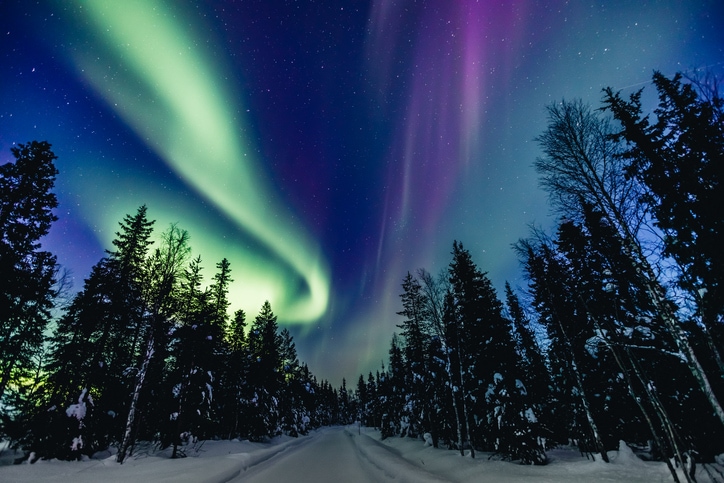What Are Aurora Borealis and How do They Form?
Introduction to the Aurora Borealis
The aurora borealis, also known as the northern lights, is one of nature’s most spectacular light displays. This mesmerising phenomenon lights up the night sky with vibrant colours, ranging from greens and pinks to purples and reds. The term “aurora borealis” is derived from the Roman goddess of dawn, Aurora, and the Greek name for the north wind, Boreas. While the northern lights can be seen in various parts of the world, Finnish Lapland is one of the prime locations to witness this natural wonder.
At VALO Finland, we aim to provide our guests with an immersive experience of Lapland, including the opportunity to witness the aurora borealis in all its glory. Our luxury villas offer the perfect vantage point to enjoy this celestial display, ensuring that your stay is both comfortable and unforgettable.
The Science Behind Auroral Formations
The aurora borealis is a result of interactions between the solar wind and the Earth’s magnetic field. The solar wind, a stream of charged particles emitted by the sun, travels through space and occasionally collides with the Earth’s magnetosphere. When these charged particles, primarily electrons and protons, enter the Earth’s atmosphere, they collide with gas molecules such as oxygen and nitrogen.
These collisions excite the gas molecules, causing them to emit light. The specific colours of the aurora depend on the type of gas involved and the altitude at which the collisions occur. For instance, oxygen at higher altitudes (above 150 miles) produces red auroras, while at lower altitudes (up to 60 miles), it emits green light. Nitrogen, on the other hand, can produce blue or purplish-red auroras.
The intensity and frequency of auroral displays are influenced by solar activity, which follows an 11-year cycle. During periods of high solar activity, known as solar maximum, the chances of witnessing a vibrant aurora borealis increase significantly.
Different Types of Auroras
Auroras are not a one-size-fits-all phenomenon; they come in various shapes and forms. The most common type is the “arc,” a smooth, curved band of light that stretches across the sky. These arcs can evolve into more complex shapes, such as “curtains” or “drapes,” which resemble flowing fabric. Another fascinating form is the “corona,” where the aurora appears to radiate from a central point, creating a crown-like effect.
In addition to these shapes, auroras can also vary in colour and intensity. The most frequently observed colour is green, but under the right conditions, you might also see pink, red, blue, or violet hues. The variations in colour and form make each auroral display a unique and unforgettable experience.
Best Places and Times to Witness the Aurora Borealis
Finnish Lapland is one of the best places in the world to witness the aurora borealis. The region’s location within the auroral oval—a ring-shaped zone around the magnetic poles where auroras are most likely to occur—makes it an ideal spot for aurora hunting. Popular locations in Lapland include Saariselkä, Levi, and Rovaniemi.
The best time to see the northern lights in Lapland is during the winter months, from late September to early April. During this period, the nights are long and dark, providing optimal conditions for aurora viewing. The peak times for auroral activity are typically between 9 PM and 1 AM, although displays can occur at any time during the night.
For the best experience, consider joining a guided aurora tour. These tours are led by experienced northern lights hunters who know the best times and places to see this phenomenon. Additionally, many accommodations in Lapland, including our VALO Ice Cube Villas, offer aurora alerts to ensure you don’t miss this magical display.
Cultural Significance and Folklore Around Auroras
The aurora borealis has captivated human imagination for centuries, inspiring a wealth of myths and legends. In Finnish folklore, the northern lights are known as “revontulet,” which translates to “fox fires.” According to legend, the lights are created by a magical fox sweeping its tail across the snow, sending sparks into the sky.
In other cultures, the aurora borealis has been associated with various spiritual and mystical beliefs. The Inuit of North America believed that the lights were the spirits of their ancestors playing a game of football with a walrus skull. In Norse mythology, the auroras were thought to be reflections from the shields of the Valkyries, warrior maidens who escorted fallen soldiers to Valhalla.
These rich cultural narratives add an extra layer of wonder to the experience of witnessing the northern lights, making it not just a visual spectacle but also a journey through history and mythology.
Conclusion
The aurora borealis is a breathtaking natural light display that offers a unique and unforgettable experience. Understanding the science behind auroral formations, the different types of auroras, and the best places and times to witness them can enhance your appreciation of this celestial phenomenon. Additionally, the cultural significance and folklore surrounding the northern lights add a fascinating dimension to this already magical experience.
At VALO Finland, we are committed to providing our guests with the best possible experience of Lapland, including the opportunity to witness the aurora borealis. Our luxury villas, combined with our comprehensive holiday services, ensure that your stay is both comfortable and enriching. Whether you’re a seasoned aurora hunter or a first-time visitor, the magic of Lapland awaits you.
